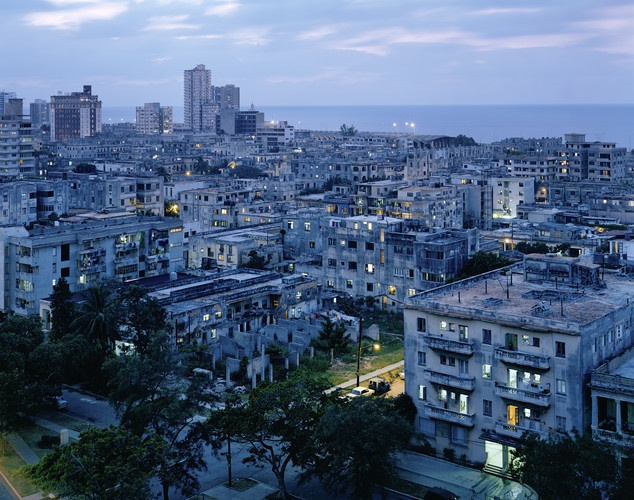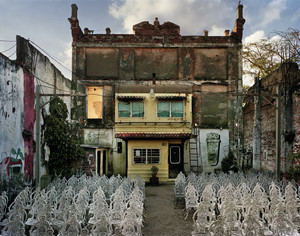
Presidents Barack Obama and Raúl Castro stunned the world on December 17, 2014, when they announced that the United States and Cuba would restore diplomatic relations after 55 years of estrangement. The news incited jubilation on the streets of Havana and condemnation in Miami from the dwindling cadre of hard-liners who oppose interaction with the island’s Communist regime. Among a growing majority of Americans, the reaction was “It’s about time,” though I, for one, did not expect such sweeping changes while anyone named Castro still held power. Besides plans to open an embassy in Havana, the White House laid out a menu of changes to be made by executive action, including relaxing travel restrictions, broadening categories of approved export and import products, and permitting U.S. financial institutions to operate in Cuba (with the use of credit cards, for example).
 |
| Photo © Andrew Moore The Reguero Theater in Morón, built in 1922, lost its roof in a cyclone 11 years later and was used as a boxing arena and a cabaret before becoming a theater again in 2004. Seen above in 2012.
|
As the implications of détente sink in, I pause to consider what it might mean for architecture—its practice, appreciation, and preservation—in Cuba. The island nation is rightly proud of its architectural legacy, older by a century than anything in North America and unrivaled in quality right through Midcentury Modernism, including radical experimentation during the first decade after the 1959 revolution. But the economic embargo imposed by the United States in 1960 and failures of the socialist economy slowed architectural production in Cuba in the 1970s and ’80s; since the collapse of the Soviet Union in 1991 and the end of East Bloc subsidies, the island’s rich built heritage has been on an inexorable slide toward demolition by neglect.
On the other hand, the country’s ideology and scarce resources have spared Cuba the depredations of late 20th-century development—no urban renewal, no highways slicing through cities, no vast swaths of mediocre modern construction. Cuba today retains historic urban neighborhoods that are deteriorated but intact, vast unspoiled countryside, and miles of pristine coastline. With the restoration of ties to the U.S., the conditions that brought about the island’s state of “preservation by poverty” are poised to change.
The thaw in Cuban-American relations promises to open up significant commercial opportunities to U.S. companies, including architectural firms, but far-reaching normalization with Cuba won’t happen until the embargo against Cuba is lifted, and that will require an act of Congress. The new Republican majority is unlikely to deliver that during Obama’s two remaining years in office. But we may be surprised: the farm states have long sought to raise the cap on agricultural exports to Cuba, and American real-estate developers and hospitality operators won’t stand by quietly while Spanish, French, Canadian, and Chinese companies build hotels and resorts across the island.
So pressure from the business community will ultimately undo the embargo, but even then, the Cuban government’s obsession with maintaining tight control over all economic activity is sure to frustrate American developers (and their architects) when they enter the market, just as it vexes the Europeans now active on the island. And the woeful obsolescence of Cuba’s infrastructure—roads, sewers, water, electricity—puts a stricture on new development, even as an impending surge in North American tourism will require thousands of new hotel rooms. All of which is to say that the feared invasion of developers from the United States “when Cuba opens up,” will probably unfold in slow motion and, I hope, at a pace that will allow conscientious environmental and historic-preservation controls to prevail.
In the meanwhile, the beautiful city of Havana continues to crumble. The government has executed masterful restorations in the colonial core of Old Havana and rescued many principal monuments, but in less fortunate neighborhoods, living conditions are deplorable and building collapses common. For the city’s splendid modern architecture, the Office of the Historian of the City of Havana (which directs most restoration work) has yet to focus equal attention on preservation.
With the expansion of Cuban-American trade, the upswing of tourism, and the increase of remittances from the north to finance the small-scale private enterprises that the Castro regime has recently allowed, an infusion of capital might help stem the decline of the city before it’s too late. The single best thing that can happen for the preservation of Cuba’s architectural legacy is the revival of the island’s moribund economy, but the Cuban government must also resist the fast money to be gained by selling off development rights for ill-conceived projects, which could be just as destructive to the city as its current entropy.
One immediate benefit to the architectural community will be easier travel. While ordinary tourism—sun and fun—is still banned, certain categories of travelers (including journalists and professional researchers, which covers many academic architects) will be allowed to visit Cuba without obtaining a special visa. This will enhance interaction between American and Cuban architects and preservationists, allowing the exchange of ideas and technical information, and potential collaboration.
Friends and colleagues want to rush to Cuba “before it changes.” My response is yes, of course, visit Cuba—but you have time. It’s not going to happen overnight. I also admonish people not to view change in Cuba as something to be dreaded. Cuba does not exist as a time-warp curiosity shop for our amusement or prurient fascination with ruins. It’s a vibrant nation of people who desperately need and deserve improvement in their lives. Raúl Castro has stated unequivocally that new diplomatic and commercial ties with the U.S. do not herald any deviation from Cuba’s socialist path, and I sincerely hope that Cuba can reboot the positive achievements of the revolution (in areas like medicine and education) and avoid the extreme income inequality that infects capitalist society today. One thing certain is that future relations are far more likely to encourage the evolution of an increasingly open civil society in Cuba than the failed policies of the past. This is what the Cuban people need the most.


Post a comment to this article
Report Abusive Comment